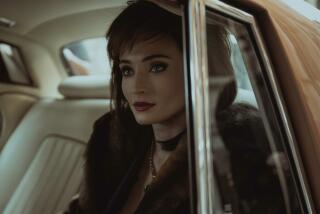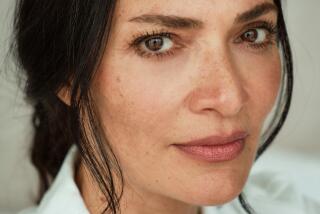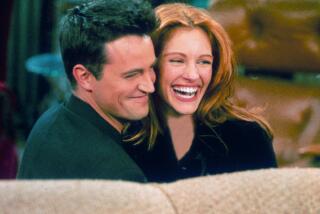Review: FX’s ‘Feud: Bette and Joan’ delves into the combustible rivalry between Bette Davis and Joan Crawford
- Share via
Joan Crawford was a star of epic proportions. Bette Davis was an unparalleled talent. Together they were a combustible combination of ego and ambition.
Now their infamous rivalry is depicted in Ryan Murphy’s eight-episode FX anthology series, “Feud: Bette and Joan,” which premieres Sunday. The series says as much about the two late actresses as it does about how Hollywood did, and still does, treat women.
It’s 1961, and former leading lady Crawford (Jessica Lange) can’t get arrested in this town. Roles for women past 40 (she’s in her 50s) are scarce, and she’s been deemed “box office poison” by the trades since her last few films flopped. Exasperated, Crawford pushes aside the “mother” roles her agents keep suggesting and searches for a story worthy of her talents. She finds “What Ever Happened to Baby Jane?,” the twisted tale of a deadly sibling rivalry between an aging actress and her disabled sister.
Crawford knows the only way to make this picture pop is to pull in formidable, two-time Oscar winner Davis (Susan Sarandon). The “All About Eve” actress has also aged out of the starlet demographic, and though she’s still highly respected, her career is on the backslide. She needs this role, but there’s a caveat – both women hate each other.
Their mutual rancor has developed over decades of competing for the same roles and awards. Now they must work together to revitalize their careers, but there aren’t enough martinis, nightcaps or morning cups of coffee spiked with gin to make their endeavor anything less than excruciating.
Their feud, however, is also very valuable. It’s exploited by the studio, the director, the press and both actresses to draw attention to the production and put them back in the spotlight.
Lange and Sarandon play these roles like they know what it means to age in an industry where sex appeal is the main currency, because, well – they do. Both had top-billing in big films of the ’80s and ’90s and have won a leading actress Oscar (Lange in fact bested Sarandon in 1995.). And both have appeared in fewer major motion-picture roles as they’ve matured.
Lange, who has become an award-winning staple in Murphy’s television repertory company, portrays Crawford as a master manipulator who’s as conniving and desperate as she is charming and shrewd. Decades of navigating a cruel studio system have made her tough, while fame has made her insufferably entitled. Above all, she’s determined to get back in the game, and you can’t help but root for a woman who fires a whole room of William Morris agents with two unprintable words when they try to sideline her.
Lange nails the role, smiling and sneering through crimson lipstick, over-enunciating each syllable as she laments that bimbos like Marilyn Monroe have taken over Hollywood, gliding and then staggering around her mansion, cigarette in hand, silk dressing gown brushing across marble floors.
She is obsessed with Davis, whom she refers to as “queen bitch”: “I admire her talent and craft. But I will get her respect, even if I have to kill both of us to get it!”
Sarandon is handed a harder task in playing the larger-than-life, outspoken Davis. Davis doesn’t care as much as Crawford about the lines on her face as she does maintaining her spot as the best actress. She’s a fiery, straight-shooter who sees Crawford as an inferior talent. She has no edit button, and for Sarandon, that means bringing her character to the edge without going over the top. Sarandon pulls it off most of the time, depicting Davis as a woman who continually pushes herself as an actor – if only there was challenging enough material.
On the “Baby Jane” set, Davis uncharacteristically compliments Crawford’s acting skills. Crawford laps it up like a needy child: “Really?” Davis says yeah, sure, but your character is supposed to be a recluse so “lose the shoulder pads and cut back on the lipstick!”
As for the rest of the cast – Murphy continues to attract A-list talent.
Alfred Molina plays put-upon “Baby Jane” director Robert Aldrich, Stanley Tucci the cruel studio chief Jack Warner. (“Would you give either of these broads a toss in the hay?” he asks Aldrich, arguing that Crawford and Davis are no longer bankable). Judy Davis portrays gossip columnist Hedda Hopper. “Feud” also features other notable classic screen stars who relish in retelling the tale including Kathy Bates as Joan Blondell and Catherine Zeta-Jones as Olivia de Havilland.
“Bette and Joan” isn’t as deep or all-encompassing as “The People v. O.J. Simpson,” but it’s addictive all the same. Watching these two powerhouse actresses play two powerhouse actresses who came before them is entertainment enough. The bitingly funny one-liners and the kitschy trimmings of yesteryear are delicious icing on this series, which shows how much the world has, and hasn’t, changed for powerful women and the men who fear them.
“Feud: Bette and Joan”
Where: FX
When: 10 p.m. Sunday
Rating: TV-MA-L (may be unsuitable for children under the age of 17 with an advisory for coarse language)
More to Read
The complete guide to home viewing
Get Screen Gab for everything about the TV shows and streaming movies everyone’s talking about.
You may occasionally receive promotional content from the Los Angeles Times.







